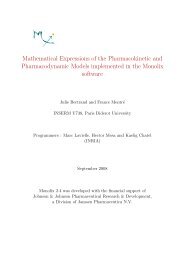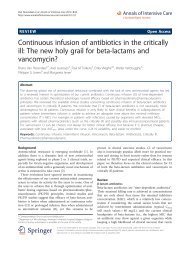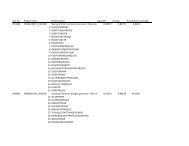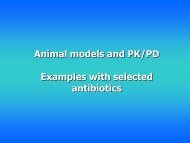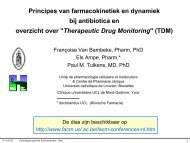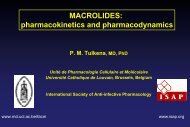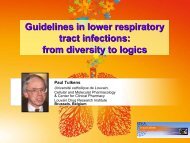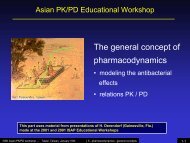Download presentation as PDF file - Cellular and Molecular ...
Download presentation as PDF file - Cellular and Molecular ...
Download presentation as PDF file - Cellular and Molecular ...
Create successful ePaper yourself
Turn your PDF publications into a flip-book with our unique Google optimized e-Paper software.
Efflux Mechanisms of<br />
Fluoroquinolones <strong>and</strong> β-lactams<br />
Paul M. Tulkens, MD, PhD<br />
Françoise Van Bambeke, PharmD, PhD<br />
<strong>Cellular</strong> <strong>and</strong> <strong>Molecular</strong> Pharmacology Unit<br />
Catholic University of Louvain,<br />
Brussels, Belgium<br />
http://www.md.ucl.ac.be/facm<br />
MSD Closed Research Update<br />
Chicago, IL.<br />
September 14, 2003
Why efflux ?<br />
polar compound<br />
lipophilic<br />
compound<br />
highly polar or highly lipophilic compounds<br />
do not e<strong>as</strong>ily p<strong>as</strong>s across membranes ...
Why efflux ?<br />
amphiphilic<br />
compound<br />
Amphiphilic ??<br />
a compound that is both polar<br />
<strong>and</strong> non-polar<br />
(ex.: a glucuronoconjugate)<br />
amphiphilic compounds<br />
e<strong>as</strong>ily invade cells
Why efflux ?<br />
But a diffusible compound<br />
may have<br />
potentially harmful effects in<br />
cells !
Why efflux ?<br />
ion gradient<br />
ATP hydrolysis<br />
Efflux transporters are a general mean of protection<br />
of the cell against inv<strong>as</strong>ion by diffusible molecules
Why DRUG efflux transporters ?<br />
Most of our drugs are made amphiphilic !<br />
to allow them to diffuse <strong>and</strong> penetrate<br />
in cells <strong>and</strong> tissues ...
Most antibiotics are amphiphilic !<br />
Van Bambeke et al. Biochem. Pharmacol. (2000) 60: 457-470<br />
Neutral<br />
apolar<br />
polar<br />
chloramphenicol
Most antibiotics are amphiphilic !<br />
Van Bambeke et al. Biochem. Pharmacol. (2000) 60: 457-470<br />
anionic<br />
fluoroquinolones beta-lactams fusidic acid
Most antibiotics are amphiphilic !<br />
cationic<br />
lincosamides<br />
macrolides<br />
tetracyclines<br />
fluoroquinolones sulfamides rifampicin
Antibiotic cl<strong>as</strong>ses recognized by efflux pumps<br />
in different types of organisms<br />
Antibiotic bacteria fungi superior<br />
cl<strong>as</strong>s Gram (+) Gram(-) eucaryotes<br />
β-lactams<br />
fusidic acid<br />
macrolides<br />
streptogramins<br />
tetracyclines<br />
aminoglycosides<br />
chloramphenicol<br />
rifamycins<br />
sulfamides<br />
trimethoprim<br />
fluoroquinolones
Identification of efflux pumps<br />
b<strong>as</strong>ed on genome sequencing data<br />
http://www-biology.ucsd.edu/~msaier/transport/<br />
identification of genes encoding for putative transporters<br />
in the genome of<br />
• 87 bacteria S. aureus, S. pneumoniae, E. coli, P. aeruginosa, ...<br />
• 14 archea<br />
• 4 eucaryotes S. cerevisiae, P. falciparum, ...
Rosenberg et al. (2003) JBC 278: 8294-8299<br />
Structure of pumps in eucaryotic cells<br />
Current view of the structure of P-glycoprotein<br />
- ATP + ATP
Van Bambeke et al. JAC (2003) 51: 1055-1065<br />
Structure of pumps in procaryotic cells<br />
AB<br />
pore<br />
AB<br />
porin<br />
AB AB AB<br />
H + Na +<br />
ATP ADP<br />
lipoprotein<br />
H +<br />
peripl<strong>as</strong>m<br />
H + Na + pump<br />
H +<br />
RND<br />
MFS<br />
SMR<br />
MATE ABC RND, MFS, ABC<br />
Gram-positive<br />
Gram-negative
Efflux pumps in bacteria:<br />
what does it mean for resistance ?<br />
! Constitutive expression of efflux pumps<br />
" intrinsic resistance<br />
! Inducible expression of efflux pumps<br />
" acquired resistance<br />
! Cooperation with other mechanims of resistance<br />
! Selection of other mechanisms of resistance
P. aeruginosa seems to be constitutively resistant<br />
to many antibiotics ...<br />
Li et al. AAC (1995) 39:1948-1953
Disruption of MexAB-OprM restores the activity<br />
of several antibiotics against P. aeruginosa<br />
Li et al. AAC (1995) 39:1948-1953
Efflux pumps in bacteria:<br />
what does it mean for resistance ?<br />
! Constitutive expression of efflux pumps<br />
" intrinsic resistance<br />
! Inducible expression of efflux pumps<br />
" acquired resistance<br />
! Cooperation with other mechanims of resistance<br />
! Selection of other mechanisms of resistance
Overexpression of efflux pumps in P. aeruginosa upon<br />
exposure to fluoroquinolones in CF patients<br />
Jalal et al, AAC (2000) 44:710-712
Overexpression of efflux pumps in P. aeruginosa upon<br />
exposure to fluoroquinolones in CF patients<br />
Jalal et al, AAC (2000) 44:710-712<br />
Regulator of MexAB expression
Efflux pumps in bacteria:<br />
what does it mean for resistance ?<br />
! Constitutive expression of efflux pumps<br />
" intrinsic resistance<br />
! Inducible expression of efflux pumps<br />
" acquired resistance<br />
! Cooperation with other mechanisms of<br />
resistance<br />
! Selection of other mechanisms of resistance
Efflux in cooperation<br />
with other resistance mechanisms<br />
R<br />
physical<br />
clearance<br />
C<br />
O<br />
N<br />
COOH<br />
chemical<br />
clearance<br />
R<br />
R<br />
β-lactam<strong>as</strong>e<br />
C<br />
O<br />
N<br />
COOH<br />
CHN<br />
O OH<br />
COOH
Efflux in cooperation<br />
with other resistance mechanisms<br />
Mazzariol et al, AAC (2000) 44:1387-1390<br />
Contributions of the AmpC β-lactam<strong>as</strong>e <strong>and</strong> the AcrAB Multidrug<br />
Efflux System in Intrinsic Resistance of E. coli to β -lactams<br />
Efflux β-lactam<strong>as</strong>e MIC carbenicillin<br />
- - 0.2<br />
+ - 12.5<br />
Intrinsic low level<br />
resistance !
Efflux in cooperation<br />
with other resistance mechanisms<br />
Mazzariol et al, AAC (2000) 44:1387-1390<br />
Contributions of the AmpC β-lactam<strong>as</strong>e <strong>and</strong> the AcrAB Multidrug<br />
Efflux System in Intrinsic Resistance of E. coli to β -lactams<br />
Efflux β-lactam<strong>as</strong>e MIC carbenicillin<br />
- - 0.2<br />
+ - 12.5<br />
+++ - 50<br />
- + 100<br />
+ + 200<br />
+++ + 400<br />
Intrinsic low level<br />
resistance !<br />
high level<br />
resistance !
Overexpression of efflux pumps in P. aeruginosa upon<br />
exposure to fluoroquinolones in CF patients<br />
Jalal et al, AAC (2000) 44:710-712<br />
Regulator of MexAB expression
Cooperation of efflux pumps <strong>and</strong> target mutation in<br />
P. aeruginosa in CF patients<br />
+ Mutation in FQ target<br />
Jalal et al, AAC (2000) 44:710-712<br />
Regulator of MexAB expression
Cooperation of efflux pumps <strong>and</strong> target mutation in<br />
P. aeruginosa in CF patients<br />
+ Mutation in FQ target<br />
Jalal et al, AAC (2000) 44:710-712<br />
Regulator of MexAB expression
Cooperation of efflux pumps <strong>and</strong> target mutation in<br />
P. aeruginosa in CF patients<br />
+ Mutation in FQ target<br />
Jalal et al, AAC (2000) 44:710-712<br />
Regulator of MexAB expression
Efflux pumps in bacteria:<br />
what does it mean for resistance ?<br />
! Constitutive expression of efflux pumps<br />
" intrinsic resistance<br />
! Inducible expression of efflux pumps<br />
" acquired resistance<br />
! Cooperation with other mechanims of resistance<br />
! Selection of the other mechanisms of<br />
resistance
Efflux <strong>and</strong> selection of resistance to FQ<br />
Gyr<strong>as</strong>e/ Topoisomer<strong>as</strong>e<br />
FQ activity is critically dependent<br />
upon a sufficiently large<br />
intrabacterial concentration
Efflux <strong>and</strong> selection of resistance to FQ<br />
Exposure to subMIC<br />
concentrations favors<br />
the selection of<br />
target mutations !<br />
Gyr<strong>as</strong>e/ Topoisomer<strong>as</strong>e
Efflux <strong>and</strong> selection of resistance to FQ<br />
Frequency of Levofloxacin-resistant mutants in<br />
Pseudomon<strong>as</strong> aeruginosa with deletions of the efflux pump operons<br />
Pump status LVX MIC Frequency of LVXresistant<br />
mutants<br />
WT 0.25 2 × 10 7 - 4 × 10 7<br />
∆ mexAB-oprM 0.015 2 × 10 7 - 4 × 10 7<br />
∆ mexCD-oprJ 0.25 2 × 10 7 - 4 × 10 7<br />
∆ mexEF-oprN 0.25 2 × 10 7 - 4 × 10 7<br />
∆ mexAB-oprM;∆ mexEF-oprN 0.015 2 × 10 7 - 10 7<br />
∆ mexCD-oprJ; ∆ mexEF-oprN 0.25 2 × 10 6<br />
∆ mexAB-oprM; ∆ mexCD-oprJ 0.015 1 × 10 9<br />
∆ mexAB-oprM; ∆ mexCD-oprJ; 0.015
How to cope with efflux pumps<br />
in anti-infective therapy ?<br />
! S. pneumoniae <strong>and</strong> the correct choice<br />
of "respiratory fluoroquinolones"<br />
! P. aeruginosa<br />
! quinolones<br />
! carbapenems
MIC considerations ...<br />
Quinolone<br />
Wild-type strain<br />
MIC<br />
CIP<br />
0.5<br />
LVX<br />
MXF<br />
1<br />
0.25<br />
Are those differences important ?<br />
GAT<br />
0.25<br />
Coyle et al. AAC (2001) 45:1654-1659
Enters the quinolone pmrA efflux pump ...<br />
NH 2<br />
COOH<br />
12 transmembrane segments<br />
member of the Major Facilitator Superfamily (MFS)<br />
energized by H + gradient<br />
Gill et al. AAC (1999) 43:187-189<br />
Van Bambeke et al. (2000) Biochem. Pharmacol. 60:457-470
MIC considerations ...<br />
Quinolone<br />
Wild-type strain<br />
MIC<br />
Efflux resistant strain<br />
MIC<br />
CIP<br />
0.5<br />
8<br />
LVX<br />
MXF<br />
1<br />
0.25<br />
And look<br />
at this,<br />
now ...<br />
4<br />
0.5<br />
GAT<br />
0.25<br />
0.5<br />
Coyle et al. AAC (2001) 45:1654-1659
PK / PD considerations ...<br />
For fluoroquinolones,<br />
• efficacy is linked to AUC/MIC ratio<br />
(must be > 30 for S. pneumoniae)<br />
• prevention of resistance is linked to<br />
C max /MIC ratio<br />
(must be > 10 to prevent mutations)
Optimisation b<strong>as</strong>ed on pharmacodynamics<br />
Quinolone<br />
Wild-type strain<br />
MIC AUC/MIC C max /MIC<br />
CIP<br />
0.5<br />
92.8<br />
11.2<br />
LVX<br />
1<br />
63.6<br />
6.4<br />
MXF<br />
0.25<br />
213.6<br />
18.8<br />
GAT<br />
0.25<br />
151.8<br />
14.8<br />
moderate risk of<br />
selection of resistance !<br />
Coyle et al. AAC (2001) 45:1654-1659
Coyle et al. AAC (2001) 45:1654-1659<br />
Optimisation b<strong>as</strong>ed on pharmacodynamics<br />
Quinolone<br />
Wild-type strain<br />
Efflux resistant strain<br />
MIC AUC/MIC Cmax/MIC MIC AUC/MIC Cmax/MIC<br />
CIP<br />
0.5<br />
92.8<br />
11.2<br />
8<br />
5.8<br />
0.7<br />
LVX<br />
1<br />
63.6<br />
6.4<br />
4<br />
15.9<br />
1.6<br />
MXF<br />
0.25<br />
213.6<br />
18.8<br />
0.5<br />
106.8<br />
9.4<br />
GAT<br />
0.25<br />
151.8<br />
14.8<br />
0.5<br />
75.9<br />
7.4<br />
moderate risk High of risk of<br />
selection selection of resistance of resistance ! !
How to cope with efflux pumps<br />
in anti-infective therapy ?<br />
! S. pneumoniae <strong>and</strong> the correct choice of<br />
"respiratory fluoroquinolones"<br />
! P. aeruginosa<br />
! quinolones<br />
! carbapenems
Topology of the wide spectrum Mex pumps<br />
in Pseudomon<strong>as</strong> (RND superfamily)<br />
Van Bambeke et al. (2000) Biochem. Pharmacol. 60:457-470<br />
NH 2<br />
COOH
Functionning of the wide spectrum<br />
Mex pumps in Pseudomon<strong>as</strong><br />
outer<br />
membrane<br />
outer membrane protein<br />
OprM, J, N<br />
linker protein<br />
MexA, C, E, X<br />
inner<br />
membrane<br />
RND exporter protein<br />
MexB, D, F, Y<br />
adapted from Aeschlimann, Pharmacotherapy (2003) 23:916-924
Wide spectrum pumps in Pseudomon<strong>as</strong><br />
β-lac ML TET AG FQ Chl<br />
MexAB-OprM<br />
MexCD-OprJ<br />
MexEF-OprN<br />
MexHI-OPrD<br />
MexJK-OprM<br />
MexXY-OprM<br />
1. wide spectrum transporters<br />
" cross-resistance among most AB cl<strong>as</strong>ses<br />
Van Bambeke et al. JAC (2003) 51: 1055-1065<br />
Aeschlimann, Pharmacotherapy (2003) 23:916-924
Wide spectrum pumps in Pseudomon<strong>as</strong><br />
β-lac ML TET AG FQ Chl<br />
MexAB-OprM<br />
MexCD-OprJ<br />
MexEF-OprN<br />
MexHI-OPrD<br />
MexJK-OprM<br />
MexXY-OprM<br />
2. FQ are « universal » substrates<br />
" e<strong>as</strong>y selection of resistance<br />
Van Bambeke et al. JAC (2003) 51: 1055-1065<br />
Aeschlimann, Pharmacotherapy (2003) 23:916-924
Wide spectrum pumps in Pseudomon<strong>as</strong><br />
β-lac ML TET AG FQ Chl<br />
MexAB-OprM<br />
MexCD-OprJ<br />
MexEF-OprN<br />
MexHI-OPrD<br />
MexJK-OprM<br />
MexXY-OprM<br />
3. constitutive expression <strong>and</strong>/or inducible expression<br />
" incre<strong>as</strong>e of resistance level higher<br />
upon antibiotic exposure<br />
Van Bambeke et al. JAC (2003) 51: 1055-1065<br />
Aeschlimann, Pharmacotherapy (2003) 23:916-924
Pseudomon<strong>as</strong> <strong>and</strong> quinolone efflux<br />
Overexpressed<br />
Mex pumps<br />
AB CD EF<br />
MICs<br />
CIP 1 LVX 2 MXF 1<br />
0.1 0.125 0.8<br />
+<br />
0.4 2 3.2<br />
+<br />
0.8 2 6.4<br />
+<br />
1.6 4 12.8<br />
1<br />
Zhang et al. JAC (2001) 48: 549-552<br />
2<br />
Lomovskaya et al. AAC (2001)5: 105-116
Pseudomon<strong>as</strong> <strong>and</strong> penem efflux<br />
Mex pumps<br />
AB CD XY<br />
- - -<br />
+ * - -<br />
++ - -<br />
- ++ -<br />
- - ++<br />
MICs<br />
MERO IMI BIA PANI FARO RITI<br />
0.032 0.25 0.25 0.25 1 2<br />
0.25 1 0.5 4 512 128<br />
1 0.25 0.25 1 4096 256<br />
0.25 0.125 0.063 0.25 16 4<br />
0.063 0.25 0.25 2 4 8<br />
* clinical isolate, b<strong>as</strong>al level of expression<br />
Okamoto et al. J. Infect. Chemother (2002) 8: 371-373<br />
Okamoto et al. AAC (2002) 46:2696-2699
Pseudomon<strong>as</strong> <strong>and</strong> penem efflux<br />
Mex pumps<br />
AB CD XY<br />
- - -<br />
+ * - -<br />
++ - -<br />
- ++ -<br />
- - ++<br />
MICs<br />
MERO IMI BIA PANI FARO RITI<br />
0.032 0.25 0.25 0.25 1 2<br />
0.25 1 0.5 4 512 128<br />
1 0.25 0.25 1 4096 256<br />
0.25 0.125 0.063 0.25 16 4<br />
0.063 0.25 0.25 2 4 8<br />
* clinical isolate, b<strong>as</strong>al level of expression<br />
Okamoto et al. J. Infect. Chemother (2002) 8: 371-373<br />
Okamoto et al. AAC (2002) 46:2696-2699
Pseudomon<strong>as</strong> <strong>and</strong> penem efflux<br />
Mex pumps<br />
AB CD XY<br />
- - -<br />
+ * - -<br />
++ - -<br />
- ++ -<br />
- - ++<br />
MICs<br />
MERO IMI BIA PANI FARO RITI<br />
0.032 0.25 0.25 0.25 1 2<br />
0.25 1 0.5 4 512 128<br />
1 0.25 0.25 1 4096 256<br />
0.25 0.125 0.063 0.25 16 4<br />
0.063 0.25 0.25 2 4 8<br />
* clinical isolate, b<strong>as</strong>al level of expression<br />
Okamoto et al. J. Infect. Chemother (2002) 8: 371-373<br />
Okamoto et al. AAC (2002) 46:2696-2699
Combined mechanisms of resistance in<br />
Pseudomon<strong>as</strong><br />
R<br />
C<br />
O<br />
N<br />
COOH<br />
$ OprD porin<br />
# Mex<br />
efflux pump C N<br />
O<br />
R<br />
# AmpC<br />
β-lactam<strong>as</strong>e<br />
R<br />
CHN<br />
O OH<br />
COOH<br />
COOH
Combined mechanisms of resistance in<br />
Pseudomon<strong>as</strong><br />
R<br />
C<br />
O<br />
N<br />
COOH<br />
$ OprD porin<br />
# Mex<br />
efflux pump C N<br />
O<br />
R<br />
# AmpC<br />
β-lactam<strong>as</strong>e<br />
R<br />
CHN<br />
O OH<br />
COOH<br />
COOH
Combined mechanisms of resistance in<br />
Pseudomon<strong>as</strong><br />
R<br />
C<br />
O<br />
N<br />
COOH<br />
$ OprD porin<br />
# Mex<br />
efflux pump C N<br />
O<br />
R<br />
# AmpCR<br />
β-lactam<strong>as</strong>e<br />
COOH<br />
CHN<br />
O OH<br />
COOH
Combined mechanisms of resistance in<br />
Pseudomon<strong>as</strong><br />
R<br />
C<br />
O<br />
N<br />
COOH<br />
$ OprD porin<br />
# Mex<br />
R<br />
# AmpC<br />
β-lactam<strong>as</strong>e<br />
R<br />
efflux pump<br />
C<br />
O<br />
N<br />
COOH<br />
CHN<br />
O OH<br />
COOH
Contribution of resistance mechanisms to<br />
carbapenem resistance in Pseudomon<strong>as</strong><br />
1. Laboratory strains<br />
Resistance mechanism fold incre<strong>as</strong>e in MIC<br />
AmpC MexAB ∆OprD IMI MERO<br />
+ - -<br />
X 1 X 2<br />
Kohler et al. AAC (1999) 43: 424-427<br />
Nakae et al. AAC (1999) 43:1301-1303
Contribution of resistance mechanisms to<br />
carbapenem resistance in Pseudomon<strong>as</strong><br />
1. Laboratory strains<br />
Resistance mechanism fold incre<strong>as</strong>e in MIC<br />
AmpC MexAB ∆OprD IMI MERO<br />
+ - -<br />
- + -<br />
X 1 X 2<br />
X 1 X 2 - 10<br />
Kohler et al. AAC (1999) 43: 424-427<br />
Nakae et al. AAC (1999) 43:1301-1303
Contribution of resistance mechanisms to<br />
carbapenem resistance in Pseudomon<strong>as</strong><br />
1. Laboratory strains<br />
Resistance mechanism fold incre<strong>as</strong>e in MIC<br />
AmpC MexAB ∆OprD IMI MERO<br />
+ - -<br />
- + -<br />
- - +<br />
X 1 X 2<br />
X 1 X 2 - 10<br />
X 16 X 4<br />
Kohler et al. AAC (1999) 43: 424-427<br />
Nakae et al. AAC (1999) 43:1301-1303
Contribution of resistance mechanisms to<br />
carbapenem resistance in Pseudomon<strong>as</strong><br />
1. Laboratory strains<br />
Resistance mechanism fold incre<strong>as</strong>e in MIC<br />
AmpC MexAB ∆OprD IMI MERO<br />
+ - -<br />
- + -<br />
- - +<br />
- + +<br />
X 1 X 2<br />
X 1 X 2 - 10<br />
X 16 X 4<br />
X 16 X 32 - 128<br />
Kohler et al. AAC (1999) 43: 424-427<br />
Nakae et al. AAC (1999) 43:1301-1303
Contribution of resistance mechanisms to<br />
carbapenem resistance in Pseudomon<strong>as</strong><br />
2. Clinical strains<br />
Resistance mechanism<br />
AmpC MexAB ∆OprD<br />
# 1 low - -<br />
MIC (mg/L)<br />
IMI MERO<br />
1 0.5<br />
Pai et al. AAC (2001) 45:480-484
Contribution of resistance mechanisms to<br />
carbapenem resistance in Pseudomon<strong>as</strong><br />
2. Clinical strains<br />
Resistance mechanism<br />
AmpC MexAB ∆OprD<br />
# 1 low - -<br />
# 2 low - +<br />
MIC<br />
IMI MERO<br />
1 0.5<br />
8 - 16 2 - 4<br />
Imipenem is affected by a defect in OprD (porin)<br />
Pai et al. AAC (2001) 45:480-484
Contribution of resistance mechanisms to<br />
carbapenem resistance in Pseudomon<strong>as</strong><br />
2. Clinical strains<br />
Resistance mechanism<br />
AmpC MexAB ∆OprD<br />
# 1 low - -<br />
# 2 low - +<br />
# 3 low + +<br />
MIC<br />
IMI MERO<br />
1 0.5<br />
8 - 16 2 - 4<br />
16 16<br />
Meropenem is affected by the expression of Mex AB (efflux)<br />
Pai et al. AAC (2001) 45:480-484
Contribution of resistance mechanisms to<br />
carbapenem resistance in Pseudomon<strong>as</strong><br />
2. Clinical strains<br />
Resistance mechanism<br />
AmpC MexAB ∆OprD<br />
# 1 low - -<br />
# 2 low - +<br />
# 3 low + +<br />
#4 high - +<br />
MIC<br />
IMI MERO<br />
1 0.5<br />
8 - 16 2 - 4<br />
16 16<br />
8 - 16 2 - 16<br />
AmpC does not markedly affect imipenem or meropenem<br />
Pai et al. AAC (2001) 45:480-484
An what about ertapenem ?<br />
Susceptibility Patterns of Resistant Mutants (PAO -1 <strong>and</strong> Derivatives)<br />
Resistance<br />
mechanism<br />
D2<br />
β-la<br />
OprM<br />
ETP<br />
IPM<br />
MER<br />
CAZ<br />
LVF<br />
None (PAO-1)<br />
+<br />
Ind<br />
+<br />
4-8<br />
1-2<br />
0.5-1<br />
2-4<br />
0.5<br />
D2 (porin) ↓<br />
-<br />
Ind<br />
+<br />
8<br />
8-16<br />
2-4<br />
2<br />
0.5<br />
OprM (efflux)↑<br />
+<br />
Ind<br />
↑<br />
32<br />
1<br />
4<br />
16<br />
4<br />
βla↑<br />
+<br />
Con<br />
+<br />
16<br />
2<br />
1<br />
64<br />
0.5<br />
MK- X + Ind + 32 2 2 4 0.5<br />
The major ertapenem resistance seen in PAO-1 is not due to D2 loss,<br />
OprM overexpression or βla constitutivity - suggesting a new mechanism
A burning question ...<br />
• Could fluoroquinolones jeopardize<br />
other antibiotics through effux<br />
pumps ?
Fluoroquinolones-exposed P. aeruginosa overexpress wide<br />
spectrum efflux pumps<br />
Incubation of<br />
P.aeruginosa with<br />
(too) low<br />
concentrations of<br />
fluoroquinolones<br />
triggers the<br />
expression of the<br />
Mex transporters<br />
BEFORE it affects<br />
the gyr<strong>as</strong>e !<br />
Nb mutants<br />
8<br />
6<br />
4<br />
2<br />
0<br />
ciprofloxacin<br />
MexCD<br />
MexCD<br />
MexEF<br />
MexCD MexCD<br />
MexEF<br />
MexAB<br />
X 2 X 3 X 4 X 6<br />
Kohler et al. AAC (1997) 41: 2540 - 2543<br />
concentration (X MIC)
Mex-expressing strains become highly resistant to many<br />
antibiotics<br />
Risk of cross resistance !<br />
Rearranged from<br />
Kohler et al. AAC (1997) 41: 2540 - 2543
Perspectives:<br />
strategies to overcome resistance by efflux:<br />
en route to a rational design<br />
of efflux pump inhibitors ?
High throughput screening for the discovery<br />
of inhibitors of ‘large spectrum’ transporters<br />
library of 200,000 synthetic <strong>and</strong> natural compounds<br />
in vitro screening in combination with levofloxacin<br />
against P. aeruginosa overexpressing Mex pumps<br />
Renau et al. J. Med. Chem. (1999) 42: 4928-4931<br />
Lomovskaya et al. J. Mol. Microbiol. Biotechnol. (2001) 3: 225-236
Lomovskaya et al. AAC (2001) 45:106-116<br />
High throughput screening for the discovery<br />
of inhibitors of ‘large spectrum’ transporters<br />
" incre<strong>as</strong>e in susceptibility of clinical isolates
you can win !<br />
Shall we have a<br />
better future ?<br />
Do not deny the difficulties ! ...
Thank you for your attention ...<br />
These slides (with a series of<br />
additional ones) will be<br />
available <strong>as</strong> <strong>PDF</strong> <strong>file</strong> from<br />
here ...<br />
http://www.md.ucl.ac.be/facm<br />
click on "Conferences” <strong>and</strong><br />
look for the link to “Efflux<br />
Mechanisms of<br />
Fluoroquinolones <strong>and</strong><br />
β-lactams”,<br />
Chicago, IL, September 14th, 2003”
Additional questions ….<br />
• Is imipenem more affected than<br />
meropenem by ∆OprD (porin) ?<br />
• Why is meropenem more affected<br />
than imipenem by MexAB (efflux) ?
Why is IMI more affected than MERO by ∆OprD ?<br />
H 3 C<br />
OH<br />
IMI<br />
OH<br />
CH 3<br />
MERO<br />
O<br />
N<br />
COO<br />
S<br />
N<br />
H<br />
NH 2<br />
H 3<br />
C<br />
O<br />
N<br />
COO<br />
S<br />
NH<br />
H 3 C<br />
N<br />
CH 3<br />
736 nm/sec<br />
73 nm/sec<br />
H<br />
O<br />
OprD porin<br />
MERO enters only slowly through OprD ...<br />
Tri<strong>as</strong> et al. AAC (1990) 34:52-57<br />
" h<strong>as</strong> MERO another<br />
route of entry ?
Mao et al. Mol. Microbiol. 2002 46: 889-901<br />
Why is MERO more affected than IMI by MexAB ?<br />
OH<br />
OH<br />
CH 3<br />
MERO<br />
H 3 C<br />
C<br />
O<br />
N<br />
COO<br />
S<br />
IMI<br />
H 3<br />
N<br />
N<br />
H<br />
NH 2<br />
substrate specificity zone<br />
NH 2<br />
O<br />
COO<br />
COOH<br />
S<br />
NH<br />
H<br />
H 3 C<br />
O<br />
N<br />
CH 3<br />
differential<br />
recognition<br />
by the large<br />
peripl<strong>as</strong>mic<br />
loops<br />
of the inner<br />
membrane<br />
component ?



